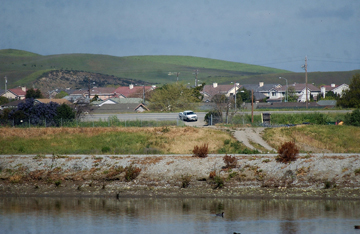
Wastewater will turn open space green
People entering Hollister’s western gateway will soon be greeted
by acres of lush city parklands.
Wastewater will turn open space green
People entering Hollister’s western gateway will soon be greeted by acres of lush city parklands.
In an unusual marriage of purposes, the Hollister City Council last week approved the purchase of some 50 acres near the western end of the San Juan Hwy. bridge. The area, commonly known as the Brigantino parcel, will be turned into athletic fields, watered with some of the treated water coming from Hollister’s new sewage plant, according to Steve Wittry, engineering manager for the city.
The $120 million treatment plant project is on its way toward completion late this year. The project was launched after Hollister’s treatment plant failed, sending some 15 million gallons of partially treated sewage into the San Benito River. State authorities subsequently ordered no new wastewater hookups in the city, leading to an effective building moratorium that’s now stretching into its sixth year.
Ironically, it’s money allocated for the sewer project that is paying for the $5 million Brigantino purchase. Although the new treatment plant will perform tertiary treatment, essentially turning sewage into water clean enough to drink, the state does not permit the city to just pour the stuff back into the San Benito River. Thus, the city must find places to use the treated effluent.
Part of the disposal plan is a separate water system that can supply water for irrigating landscaping. The water can legally be used on crops, as long as it does not directly contact the portion to be consumed. Thus, treated wastewater may be used to water fruit trees, for example, but not lettuce.
In other areas, it is also used to irrigate golf courses. With the city searching for places to put its new source of water, the Brigantino parcel emerged as a solution to several problems.
It is across San Juan Hwy. from a frontage road that contains a wrecking yard, a few homes and a string of small businesses. The field is the first significant chunk of open space on Hollister’s west side. The area now counts only one small park.
Because it’s being built with sewer funds, the city is initially limited in how “parklike” the setting can be.
“Initially it will just be grass,” Wittry said. “It’s a lot of open space. People can play soccer or ball. But we can’t do too much – even restrooms – because it’s built with sewer funds.”
Wittry said further development may be possible later. Work on the Brigantino parcel is expected to begin this summer.
The Brigantino parcel is the first link in an ambitious plan that could transform the San Benito River from a trash-choked wash to one of the area’s most attractive assets.
The city began research into a river parkway in 2001, with an eye on the Brigantino parcel as a link in a park stretching along the river.
The ponds just upstream of the San Juan Hwy. bridge will remain in use after the new treatment plant is operating, but they will only be used to catch storm runoff and to treat waste generated by Hollister’s tomato cannery. Should the cannery ever close, the city might eye turning the area into a constructed marshland laced with trails.
Initially, the new park will be separated from nearby residents by the busy highway. But it may not always be so.
“The potential is there for a footbridge … for a river park trail,” Wittry said. “But that’s a longer term objective.”
“It could be a huge attraction to birds and other wildlife,” he added.









